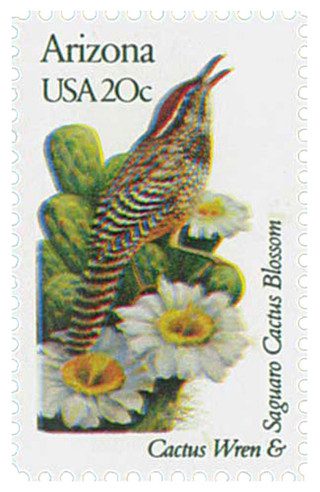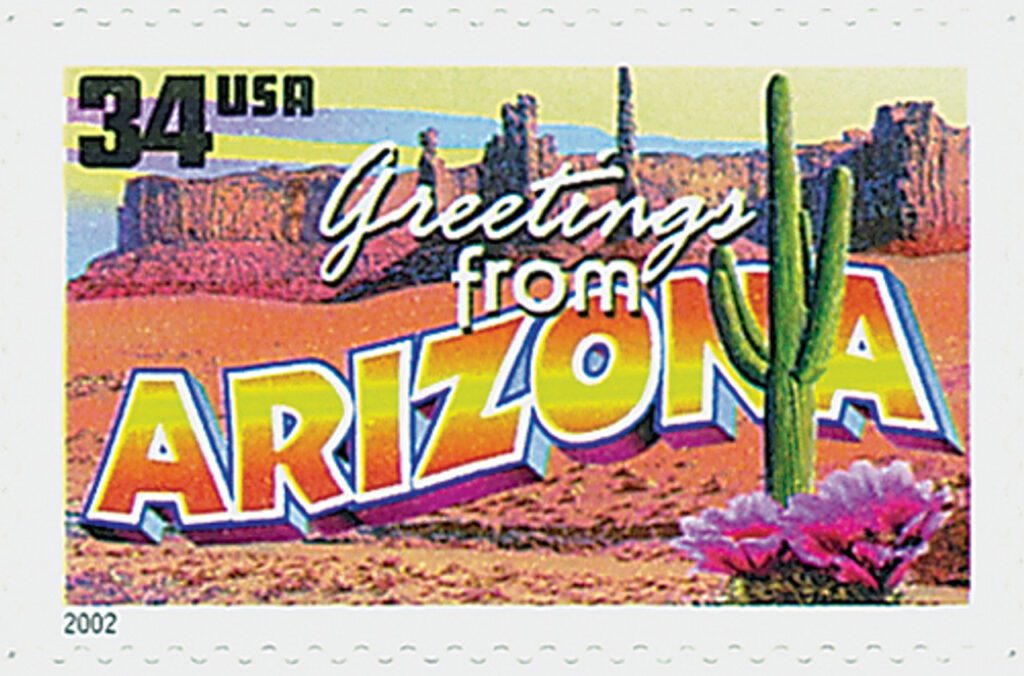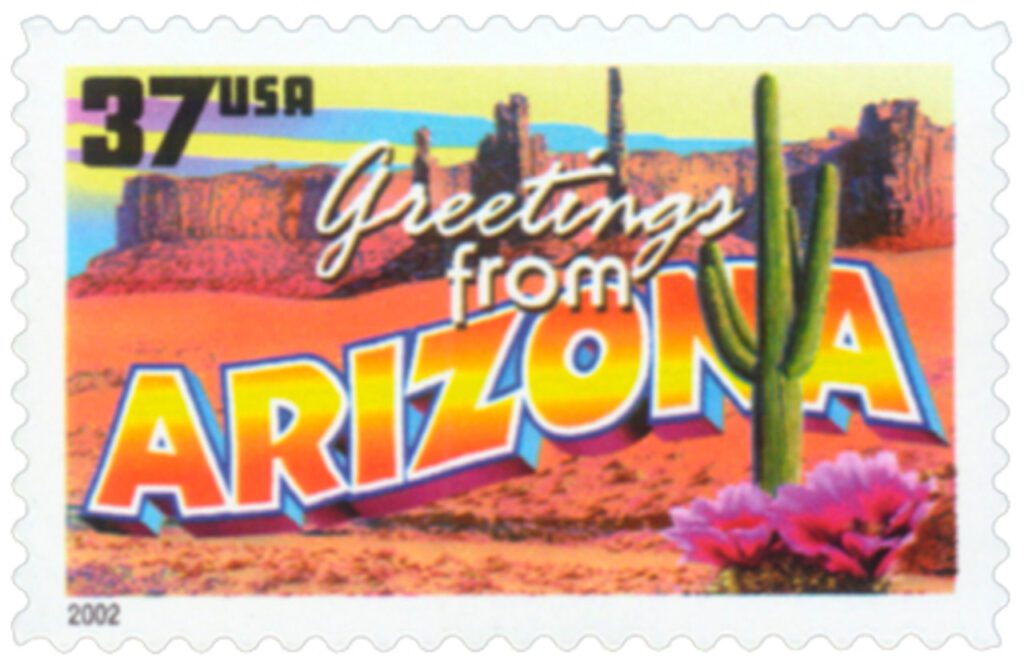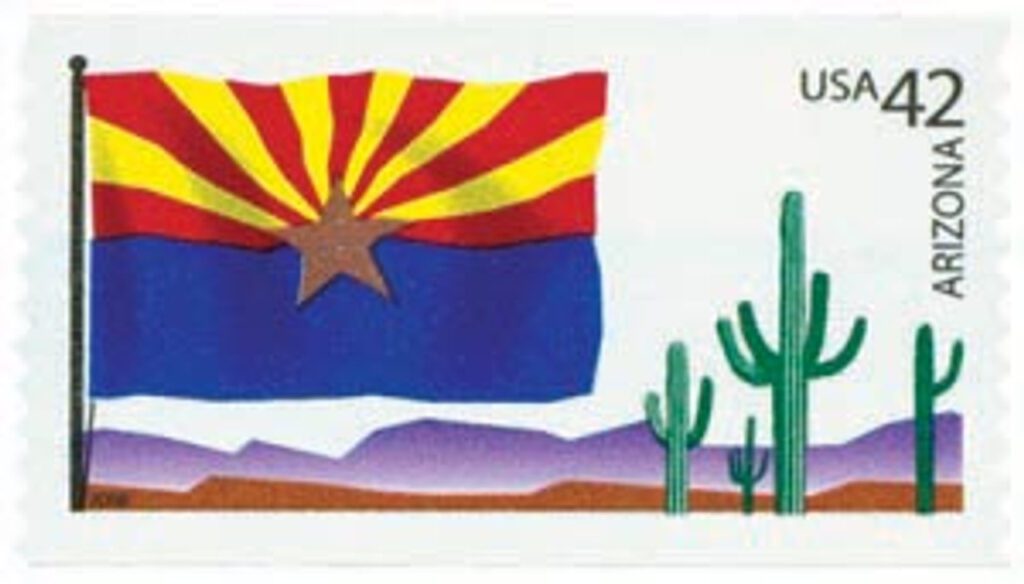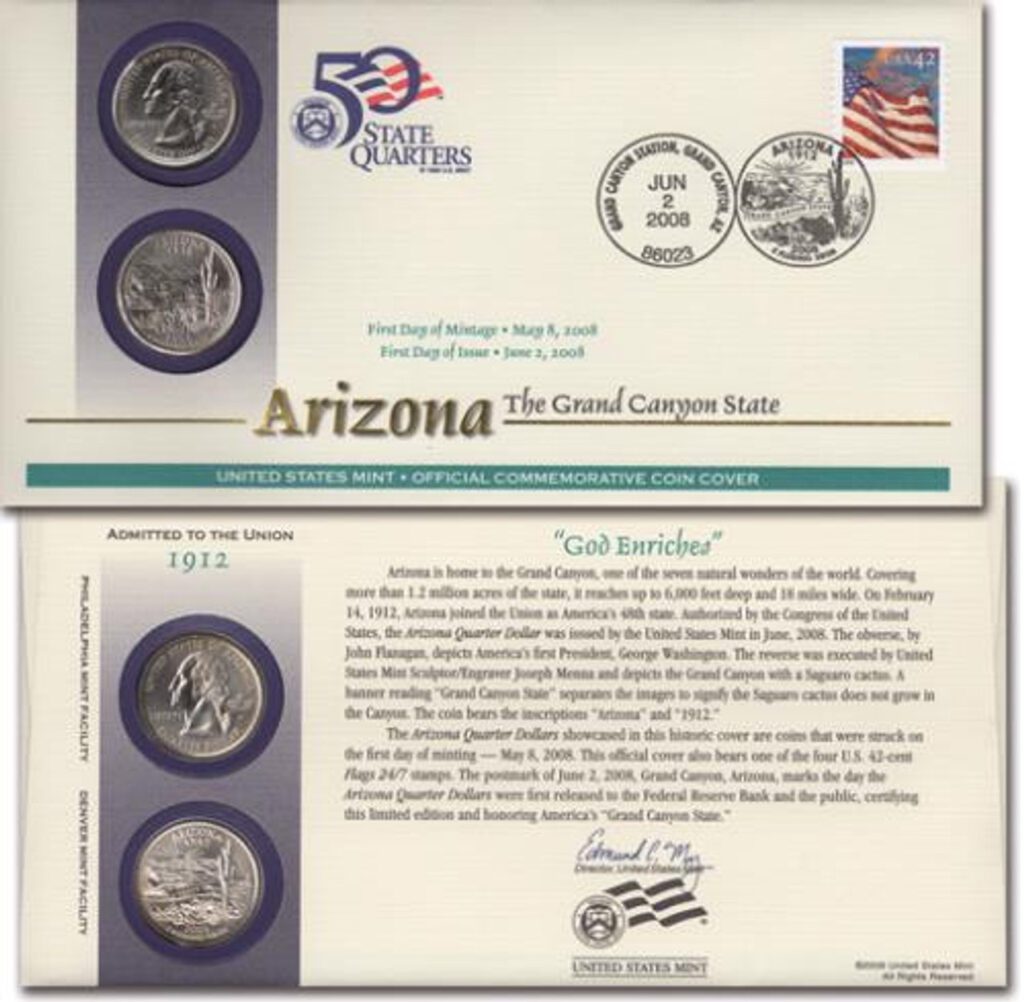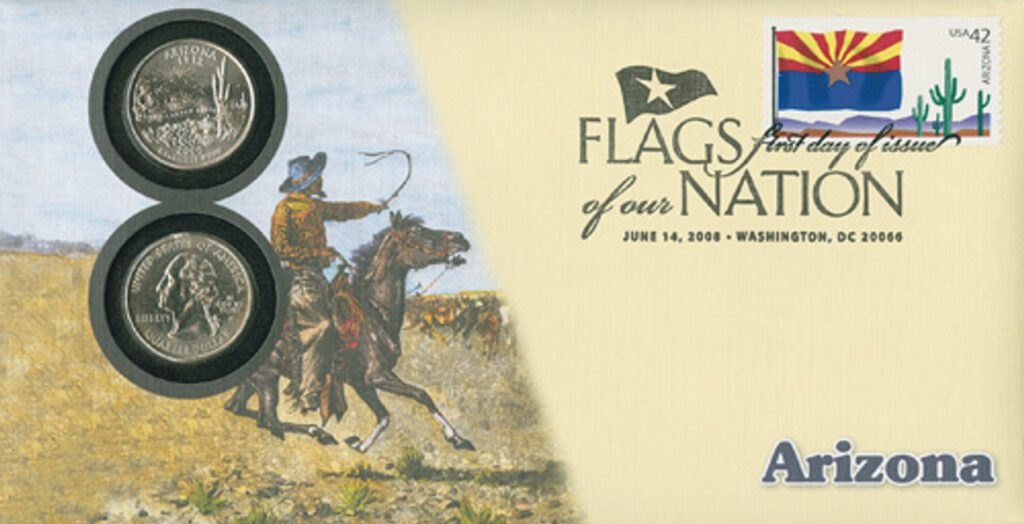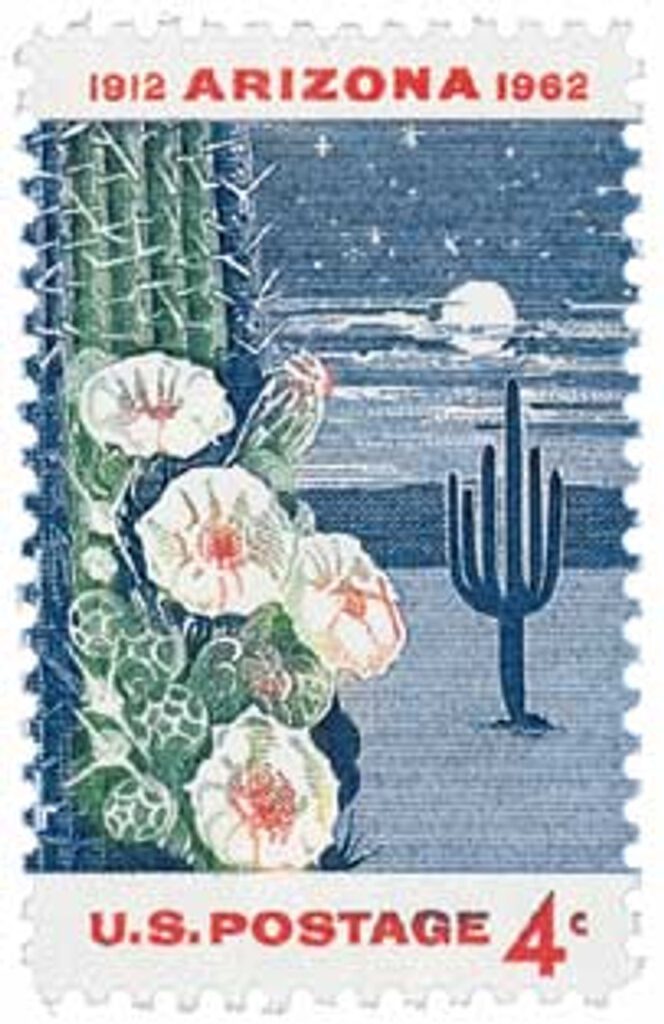
On February 14, 1912, Arizona was admitted as the 48th state. It would be another 48 years before another state was added to the Union.
Native Americans lived in Arizona thousands of years before European explorers reached the area. The Anasazi lived in the north, and were the ancestors of the Pueblo Indians. The Hohokam lived along the Gila and Salt River valleys, where they built impressive irrigation ditches. They were the ancestors of the Papago and Pima Indians. The Mogollon lived in eastern Arizona. Apache and Navajo Native Americans came to Arizona only a short time before Europeans arrived.
Stories of the Seven Cities of Cibola – said to contain great amounts of wealth – sent many Spanish explorers on futile quests into the region. A Franciscan priest, Marcos de Niza, was the first European person known to reach Arizona. He traveled through the San Pedro Valley in 1539, while searching for the seven cities. Spanish explorer Francisco Vásquez de Coronado searched for this lost wealth, but instead discovered Hopi and Zuni Indian villages in Arizona and New Mexico.
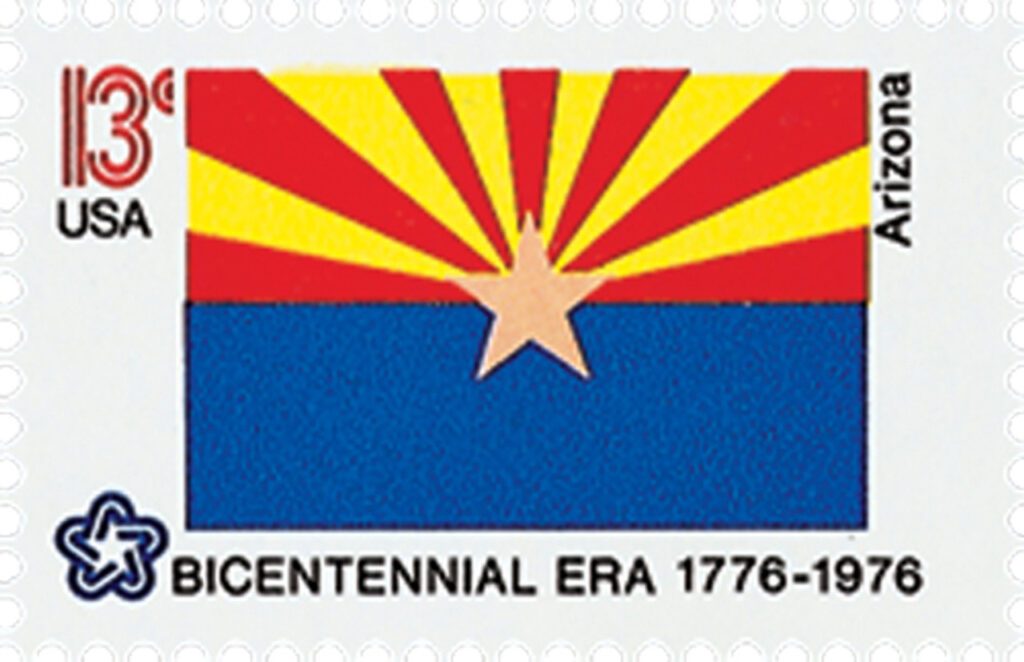
During the 1600s, Roman Catholic missionaries came to the Arizona area to establish missions. Father Eusebio Kino founded 24 missions. During one of his explorations, he reached as far north as Fairbank. The Native Americans in Arizona made several attempts to remove the Spanish. However, the Spanish were always able to regain their foothold. In 1752, the Spanish established the first European settlement at Tubac. In 1776, Tucson became a Spanish fort. It was built with thick adobe walls to protect the settlers from the Apache.
In 1821, Mexico won its independence from Spain. Arizona became part of Mexico. The United States went to war with Mexico in 1846. As a result of the Mexican-American War, most of Arizona became part of the US. The portion of Arizona south of the Gila River, which forms the border with Mexico, was acquired by the US in the Gadsden Purchase of 1853.
Arizona settlers unsuccessfully attempted to become a distinct US territory in the 1850s. Many settlers were from the South and were sympathetic to the Confederacy when it was formed in 1861. An Arizona delegate was sent to the Confederate Congress. Confederate troops were sent to Arizona in 1862, where they were defeated by Union forces. When the Confederate government created the Confederate Territory of Arizona, it was largely a symbolic gesture.
US Congress created the Arizona Territory, with roughly the same boundaries as the modern state, in 1863. John N. Goodwin became the territorial governor, establishing his headquarters at Fort Whipple. Over time, the town of Prescott grew from this tiny settlement.
The settlers in the sparsely populated Arizona Territory lived in fear of Native American attacks. In 1864, Kit Carson led forces to victory over the Navajo in New Mexico, which brought some relief in Arizona. However, small bands of fierce Apache warriors continued to stage raids throughout the region. Most of the raids were conducted against remote locations, but forces led by Cochise, Geronimo, and Mangas Coloradas also attacked forts and towns. It wasn’t until 1886 that the last raiding party, led by Geronimo, surrendered.
Arizona continued to grow, with economic growth fueled by discoveries of gold and silver. Ingenuity also aided Arizona. Farmers began irrigating their fields as early as 1867. During the 1870s and ’80s, copper mines were developed. On September 30, 1877, the Southern Pacific Railroad connected Arizona to California, further enhancing the territory’s growth.
Around 1890, well-organized groups began to lobby Congress in an effort to achieve statehood. However, Congress refused to act for 20 years. In 1910, Arizona was allowed to create a state constitution and apply for statehood. This was done, but President William Howard Taft vetoed the bill that would have granted statehood. Taft was concerned the state constitution allowed for recall – a process through which voters could remove judges from office. Once this clause was taken out of the constitution, statehood was approved. Arizona finally achieved statehood on February 14, 1912. Soon after, the people amended their constitution to allow recall of judges.
Arizona’s first governor, George W. P. Hunt, proved to be very influential in the state’s development. During his seven terms as governor, he supported the development of dams and irrigation projects and worked to pass laws favorable to ranching and mining businesses.
Arizona’s warm, dry climate lacked a sufficient water supply, so with the federal government’s help, Arizona developed its limited resources. The Theodore Roosevelt, Coolidge, and Bartlett dams opened large portions of the state to irrigation. In 1936, the biggest dam, the Hoover Dam, was completed. Development of these water resources aided the state’s economy in many ways, and especially helped tourism.
Arizona’s copper mining and agricultural industries grew during the Great Depression. This attracted many people to the state. With the start of World War II, these already prosperous industries increased rapidly. As a result, the city of Phoenix doubled in size. This economic and population boom continued into the 1950s, when air conditioning became affordable, helping to make life comfortable in this desert area.
During the 1950s and ’60s, Arizona’s economy switched from an agricultural to a manufacturing base. New industries flocked to the state. Factories began producing electronic goods, appliances, and refrigeration equipment. In 1965, Judge Lorna Lockwood was elected as the chief justice of the Arizona Supreme Court, making her the first woman in the nation to serve as the head of a state supreme court.
The Central Arizona Project was initiated in 1974 to ensure the state’s water needs would be met. The project takes water from the Colorado River and supplies the Phoenix and Tucson areas. Arizona continues to be one of the nation’s fastest-growing states. Its economy remains strong, aided greatly by its mineral resources.
| FREE printable This Day in History album pages Download a PDF of today’s article. Get a binder or other supplies to create your This Day in History album. |
Discover what else happened on This Day in History.

